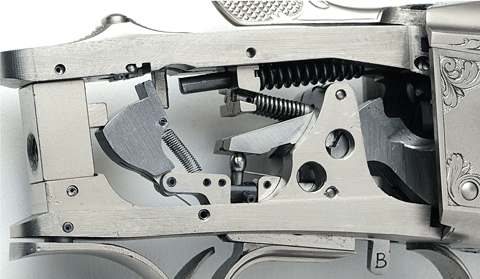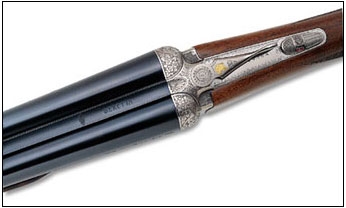When it comes to shooting shotguns, if anything goofy is in your head, it will likely show up in the trigger.
Recoil aversion, doubt over the break point, longings for banana-nut pancakes and bacon drenched in warm maple syrup — whatever distraction or bugaboo that causes you to miss a target can easily manifest as a fickle trigger finger.
Even then, assuming the target has your full concentration, the trigger is the place on the shotgun where you commit: if the trigger pull is too heavy, too light or too long the results are likely to be the same: a target that just keeps on going.
When it comes to trigger-pull weight, the ideal is between 3½ to 4 pounds for single- trigger shotguns. On a side-by-side shotgun that has two triggers, the front trigger should set at about 3½ pounds. The rear trigger can be slightly heavier due to the fact that it rests on a slightly stronger part of your finger.
Shotgun Triggers and Your Local Gunsmith
If you have any doubts about the weight of your trigger pull, you can purchase a trigger-pull gauge for anywhere between $20 and $70 — or you can visit your local gunsmith. A trigger-pull gauge is standard-issue equipment for gunsmiths.
The next problem with your trigger could be the length of pull. If it’s slightly too long or too short, you could find yourself shooting prematurely or flinching because the trigger is simply too far back for you to exert the proper pressure.
The first thing to do is check to see if your trigger is adjustable. These adjustable shotgun triggers generally come in two flavors: notched and variable. The notched variety will let you move the trigger in preset increments. The variable has no preset increments — providing a more accurate fit.
Is Your Shotgun Trigger Adjustable?
The give-away as to whether or not you have an adjustable trigger is a tiny Allen-screw in the trigger (or you could just read the manual). And if your gun did come with an adjustable trigger, the proper Allen wrench should have been packaged with your shotgun.
After adjusting the trigger, if the gun still doesn’t fit right, then its time to consider adjusting the length of the stock. You can either cut the stock or get any number of adjustable recoil pads.
One thing about shotgun triggers that may surprise you is how your efforts to combat recoil could impact your trigger performance.
Shooters with recoil problems try to address the predicament by either going with low-recoil shells or inserting tubes that allow you to shoot a smaller gauge with reduced recoil. Suddenly, you find that your trigger won’t reset on the second shot.
Here’s what happened…
Shotguns With Inertia Triggers
Most shotguns are manufactured with inertia triggers. That term is derived from a mechanism where the recoil from the first shot actually enables the trigger to get off the second shot. The prerequisite recoil set by the factory takes into account a standard off-the-shelf load that would be used for the original gauge of the shotgun.
When you manipulate the recoil, you’re also manipulating the inertia necessary to cycle the trigger for the second shot. So if you develop trigger malfunctions as you experiment with low-recoil and subgauge loads, it could be that you’re not generating enough pressure.
At that point, your recoil problems become more complicated. Do you buy a smaller gauge shotgun? Do you reload your own shells to custom-tailor your own load? Do you take the trigger to a gunsmith to see if they can adjust the trigger to a lighter load? Or do you replace the inertia trigger with a different type of trigger?
(Actually, there could be one more incredibly easy solution. Change the selector on your shotgun to reverse the order of which barrel shoots first. Most shooters want their bottom barrel to fire first. But if you select your top barrel to shoot first, it could conceivably solve the problem with inertia triggers.)
Mechanical or Release Triggers for Your Shotgun?
If you opt to replace the trigger entirely, that leaves you with two alternatives: mechanical triggers or release triggers.
With a mechanical trigger, both hammers are cocked when you break open the shotgun. By eliminating the inertia factor, the second barrel will fire when the first barrel fails to fire.
Then there are release triggers. They sound counter-intuitive, but shooters who use them can’t go back. Think of a release trigger as drawing back the string on a bow. To fire the arrow you simply release the string. It’s similar with a release trigger.
To set the trigger you pull on it as though to fire it. But the trigger won’t fire until you take your finger off it. Release triggers were originally designed for single-shot trap guns — the idea behind it that you were less likely to flinch on targets that generally flew straight out.
Over time, release triggers migrated to skeet and sporting shotguns. And the technology has grown more sophisticated. You can now either order, or have customized, just about any configuration of a release trigger.
You can have release-pull, release-release, pull-release — pretty much whatever your heart desires.
Look for the Big R on the Shotgun
Be advised: release triggers can be very dangerous in the wrong hands. In fact, any responsible shotgun owner with a release trigger will affix a sticker that sports a big R on a fluorescent background as a warning. It is highly advised not to let new shooters try release triggers, since instinctively they want to pull the trigger to fire the shotgun.
Whether or not you’re looking to solve a problem with your shooting, some shooters simply prefer different kinds of triggers to make them more successful.
Side-by-side owners really go for the original double trigger. This system predates screw-in chokes. Since early side-by-sides were mostly field guns, the barrels were choked to hit birds at different distances.
If you missed the first shot on an outgoing bird, then the assumption was that the second shot would be further away and you would need a tighter choke. For incoming birds, a wider choke ensured bagging the bird on the second shot.
To remedy the problem with fix-choked shotguns, the early side-by-sides (and the modern English variation) are fitted with two triggers in one tang. The front trigger fires the right barrel and rear trigger the left.
Shooting double-trigger shotguns is definitely an acquired skill — especially if you’re a vintage shooter.
Most shooters are happy with the standard inertia trigger. If you want to experiment with your shotgun trigger, though, you’d be pleasantly surprise at the different options available to you.





